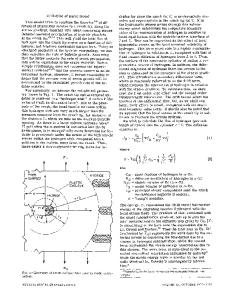Nickel/metal hydride batteries using rare-earth hydrogen storage alloy
- PDF / 444,001 Bytes
- 3 Pages / 576 x 792 pts Page_size
- 72 Downloads / 368 Views
Fine particles of a hydrogen storage alloy (LaNi3.gCoo.5Mno.4Alo.3) were microencapsulated with a thin film of nickel of about 0.6 fim thickness. The microencapsulated alloy powders were used as an anode material in a sealed nickel/metal hydride battery. The battery characteristics were compared with those of a battery with a bare (uncoated) alloy anode. The battery using the bare alloy was less stable compared to the coated alloy due to the role of the coated nickel as an oxygen barrier for protecting the alloy surface from oxidation. In addition, charge-discharge characteristics were improved greatly by the nickel coating, especially at high rates and at low temperatures due to the role of nickel as a microcurrent collector. So the microencapsulation of the alloy powders improves the performances of the alloy electrode.
I. INTRODUCTION Hydrogen storage alloys have attracted attention as electrode materials for reversible hydrogen storage1'2 because of the following attractive features. First, they have high energy densities. Second, a rapid charging by hydrogen gas is possible. Third, the properties of the electrode would be changed arbitrarily with the composition of the alloys. In addition, they would be utilized in both types of batteries: a metal oxide/metal hydride battery3'4 and an air/metal hydride battery.5'6 However, for developing a useful battery, the capacity decay of the metal hydride electrode should be overcome. Two causes for the capacity loss of the alloy are (i) oxidation of the alloy by the oxygen that is evolved on the nickel electrode and (ii) disintegration of the alloy related to the hydrogen absorption-desorption processes in the electrolytic solution processes in the electrolytic solution. Sakai et al.1 have protected the alloy from oxidation by microencapsulation of copper. They prepared alloy electrodes with the coated alloy and constructed sealed nickel/metal hydride batteries with long cycle lives. We found that the alloy exhibited characteristics suitable for electrode materials when the surface of fine particles of the alloy was coated with a thin film of nickel. By microencapsulation of the alloy, the following improvements were attained. First, electrical and thermal conductivities of the alloy powders increased remarkably. Second, oxygen resistance of the alloy surface was improved greatly. Third, the fine powders of the alloy produced by charge-discharge cycling were depressed considerably to shed from the electrode. Fourth, the electrode plate could be prepared easily from alloy powders because the coated metal linked alloy particles together. 1802
http://journals.cambridge.org
J. Mater. Res., Vol. 9, No. 7, Jul 1994
Downloaded: 23 Nov 2014
In this work, we have prepared metal hydride electrode (anode) using the microencapsulated alloy with nickel and have constructed sealed nickel/metal hydride batteries. The battery characteristics were examined such as cycle life, charge-discharge properties, temperature dependence, and self-discharge characteristics, in comparison with
Data Loading...











